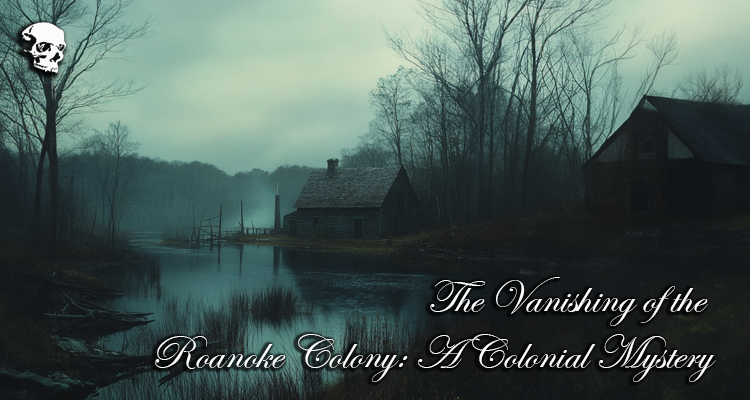Currently Empty: $0.00

The Vanishing of the Roanoke Colony: A Colonial Mystery
Roanoke Island was the first English colony in America, established in 1587 under the leadership of John White. The settlers, consisting of men, women, and children, aimed to establish a permanent English presence in the New World. However, the colony’s establishment was fraught with difficulties from the start, including conflicts with local Native American tribes and limited resources.
When John White returned to the colony in 1590 after a supply trip to England, he found it deserted. The only clue to the settlers’ fate was the word “CROATOAN” carved into a post, suggesting a possible relocation to Croatoan Island (now Hatteras Island). Despite numerous search efforts, the colonists were never found, and their fate remains a mystery. This mysterious disappearance has fueled countless theories and speculations over the centuries, making the Roanoke Colony one of the most enduring enigmas in American history.
Environmental Factors
Studies indicate that the disappearance of the Roanoke Colony coincided with a severe drought, the most extreme in 800 years, occurring between 1587 and 1589. This environmental hardship likely played a critical role in the colony’s struggle to sustain itself. The drought would have severely impacted the colonists’ ability to grow crops, secure fresh water, and maintain their livestock, leading to food shortages and weakened resilience against other challenges.
The extreme drought conditions were supported by scientific analysis of tree-ring data, which provided a clearer understanding of the environmental factors at play. The findings suggest that the settlers were confronted with one of the harshest climates in centuries, which would have made survival extraordinarily difficult. Such environmental stressors could have forced the colonists to seek help from nearby Native American tribes or relocate in search of more hospitable conditions, ultimately contributing to their mysterious disappearance.
Cultural and Social Dynamics of Roanoke
There are theories suggesting that the colonists might have integrated with local Native American tribes, such as the Powhatans, and lived among them. This hypothesis is supported by accounts of Native American tribes possessing European artifacts and reports of Native Americans with European features. The integration theory posits that the colonists, faced with insurmountable hardships, sought refuge with the indigenous populations, learning their ways and potentially assimilating into their societies.
However, this theory also carries a darker aspect. Some historians believe that while initial integration might have occurred, it could have led to tensions and eventual conflict. There are accounts suggesting that the Powhatans, under Chief Powhatan, might have massacred the integrated colonists in the early 17th century to eliminate any threat they might pose. This hypothesis, though debated, highlights the complex and often hostile interactions between the colonists and Native American tribes during that period.
Archaeological and Literary Investigations
Archaeological evidence related to the Roanoke Colony remains scarce, and much of the mystery has been kept alive through historical records and literature. The story of Virginia Dare, the first English child born in the New World, and the fate of the Lost Colony has become a significant cultural myth in American history. Various literary works and artistic interpretations have kept the story in the public imagination, often romanticizing and dramatizing the events.
Paul Green’s 1937 symphonic drama, “The Lost Colony,” is a prime example of how literature has explored and preserved the themes of environmental hardship and cultural encounters. This drama portrays the struggles of the early settlers and their interactions with indigenous tribes, providing a narrative that combines historical facts with artistic interpretation. Such works have ensured that the story of the Roanoke Colony remains a poignant and evocative part of American cultural heritage.
Scientific Analysis of the Vanishing of Roanoke
Scientific analysis has played a crucial role in understanding the potential factors behind the disappearance of the Roanoke Colony. The analysis of tree-ring data, known as dendrochronology, has provided concrete evidence of the extreme drought conditions that prevailed during the colonists’ time on Roanoke Island. This method involves examining the growth rings of trees to determine historical climate conditions, offering a precise and reliable record of environmental factors.
The tree-ring data revealed that the late 16th century experienced an unprecedented drought, which would have significantly impacted the colonists’ ability to sustain their settlement. This scientific evidence supports the theory that environmental challenges were a primary factor in the colony’s disappearance. By understanding the severity of the drought, researchers can better appreciate the formidable obstacles the Roanoke settlers faced, adding a critical piece to the puzzle of their fate.
Reflecting on the Enigma
The mystery of the Roanoke Colony likely involves a combination of environmental challenges, potential integration with Native American tribes, and subsequent conflict. Despite extensive research and speculation, the fate of the Roanoke colonists remains unresolved. Each new discovery, whether from historical records, scientific analysis, or archaeological findings, adds another layer to this enduring enigma.
While definitive answers may still elude us, the story of the Roanoke Colony continues to captivate the imagination of historians, researchers, and the general public. The disappearance of the Roanoke settlers serves as a poignant reminder of the perils and uncertainties faced by early explorers and colonists in the New World. As new methods and technologies emerge, there is hope that one day the full story of the Lost Colony may finally be uncovered, bringing closure to one of America’s oldest mysteries.
Are you enjoying this article or our site? Love of Gothic and the Dark Matters & Mischief magazine are run by dedicated volunteers, and we rely on crowdfunding to cover our expenses. Your support is crucial to keep us going! Consider becoming a paying member of our Patreon or purchasing something from our shop to help us continue providing content and community support. Thank you for your support!
